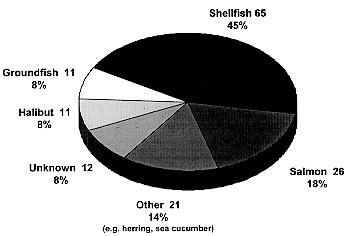Commercial Fishing Fatalities in Alaska Risk Factors and Prevention Strategies
September 1997
DHHS (NIOSH) Publication Number 97-163
Commercial Fishing Fatalities in Alaska Risk Factors and Prevention Strategies
Foreword
The purpose of the Occupational Safety and Health Act of 1970 (Public Law 91-596) is to assure safe and healthful working conditions for every working person and to preserve our human resources. In this Act, the National Institute for Occupational Safety and Health (NIOSH) is charged with recommending occupational safety and health standards and describing exposures that are safe for various periods of employment, including (but not limited to) the exposures at which no worker will suffer diminished health, functional capacity, or life expectancy as a result of his or her work experience.
Current Intelligence Bulletins (CIBs) are issued by NIOSH to disseminate new scientific information about occupational hazards. A CIB may draw attention to a formerly unrecognized hazard, report new data on a known hazard, or disseminate information about hazard control. CIBs are distributed to representatives of academia, industry, organized labor, public health agencies, and public interest groups as well as to Federal agencies responsible for ensuring the safety and health of workers.
Each year in Alaskan waters, an average of 34 fishing vessels and 24 lives are lost in the commercial fishing industry, which equates to an occupational fatality rate of 140/100,000 workers/year, 20 times the national average. The extremely high risk of fatal injury to commercial fishers provided the impetus for NIOSH efforts to more comprehensively identify risk factors and prevention strategies within the commercial fishing industry.
This CIB reviews what is known about fatal fishing incidents in Alaska, defines problems, describes recent successes, and recommends general approaches to preventing fatal events. Our hope is that this document will serve as a catalyst to further injury prevention efforts to reduce commercial fishing fatalities in Alaskan waters, and other regions involved in cold water fishing.
[signature]
Linda Rosenstock, M.D., M.P.H.
Director, National Institute for
Occupational Safety and Health
Centers for Disease Control and Prevention
Abstract
This document describes the fatal events in the Alaska commercial fishing industry and recommends strategies to prevent or reduce the seriousness of these events.
Fishing fatality rates vary substantially by fishery. Alaskan fisheries differ in geographic location of fishing grounds, type of harvesting equipment and techniques, time of year, and duration. Crabbing is particularly hazardous, because harvesting of most crab species in Alaska generally takes place during the winter months, with short daylight hours and often in rough weather conditions.
The etiologic factors for Alaska commercial fishing deaths are complex. Type of harvesting equipment and techniques, fatigue, and environmental conditions contribute to the severity of these events. The critical factors that must be addressed for definitive prevention efforts in this industry are vessel stability and hull integrity, training and licensing of skippers and crew, management practices, human factors, avoidance of the harsh sea and weather conditions, falls overboard, and unsafe diving practices.
The progress made in the previous six years in saving the lives of fishermen has occurred primarily in saving lives after a vessel casualty. Fishermen now generally know how to use the safety equipment required by the Commercial Fishing Industry Vessel Safety Act and the highly effective men and women of the U.S. Coast Guard are often able to rescue them. We recommend augmenting this approach to commercial fishing fatalities by preventing these disasters in the first place, as well as preparing to react to them if they should occur.
Acknowledgments
This document was prepared by Jennifer M. Lincoln, B.S., CSP, and George A. Conway, M.D., M.P.H., of NIOSH, Alaska.
The authors would like to thank the following individuals for their assistance in preparing this document: Linda Ashley, NIOSH, Alaska; LT Alan Blume, United States Coast Guard (USCG), Anchorage Marine Safety Office (MSO); Jerry Dzugan, Director, Alaska Marine Safety Education Association (AMSEA); Sue Jorgensen, USCG 17th District, Juneau; Michael Klatt, NIOSH, Alaska; Charlie Medlicott, USCG, Anchorage MSO; and CAPT Ed Thompson, USCG, Anchorage MSO.
Editorial review and production assistance were provided by Linda Morton and Joyce Spiker, respectively.
Agency Acknowledgments
Alaska Commercial Fisheries Entry Commission
Alaska Department of Fish & Game
Alaska Department of Health and Social Services
Bureau of Vital Statistics
Emergency Medical Services
Section of Epidemiology
Alaska Department of Labo
Bureau of Labor Statistics
Labor Standards and Safety Division
Alaska Marine Safety Education Association
Alaska State Troopers
Federal Occupational Safety and Health Administration
National Marine Fisheries Service
National Transportation Safety Board
National Weather Service
North Pacific Fishery Management Council
University of Alaska
United States Coast Guard, 17th District
Public Health Summary
What are the hazards?
Each year in Alaskan waters, an average of 34 fishing vessels and 24 lives are lost in the commercial fishing industry. This represents an occupational fatality rate of 140/100,000/year, 20 times the national average. Most of the deceased fishermen drowned, are presumed drowned, and/or died from hypothermia as a result of either vessel-related events (capsizing or sinking’s), or falling overboard. Some of the factors that put workers in the commercial fishing industry at risk are working on open, unstable platforms (decks); fatigue; and environmental conditions.
How can a worker be exposed or put at risk?
Any worker in the commercial fishing industry can become a fatality, but the risks are much greater in certain fisheries, which differ in geographic location of fishing grounds, type of harvesting equipment and techniques, time of year, and duration of respective fishing seasons. For the Alaskan commercial fishing industry, crab fishermen have the highest risk for a fatality. Crabbing is particularly hazardous because harvesting of most crab species in Alaska generally takes place during the winter months, often in conditions of cold air and water temperatures, high winds, snow, sleet, ice, short daylight hours, and high seas.
What recommendations has the Federal government made to protect workers’ health?
The hazards of commercial fishing captured the attention of Congress, which enacted the Commercial Fishing Industry Vessel Safety Act (CFIVSA) of 1988. This Act required, among other things, each vessel to carry various survival equipment. The United States Coast Guard (USCG) is charged with enforcing these requirements. The Act also directed the Secretary of Transportation to conduct an assessment of safety problems in the industry. This safety assessment was completed by the National Research Council (NRC) of the National Academies of Sciences and Engineering and its findings were published in 1991. Their recommendations included proposals for safety administration and for alternatives that are related to vessels, personnel, survival, and fisheries management. The National Transportation Safety Board (NTSB) has also proposed several safety recommendations for the commercial fishing industry. NIOSH recommendations focusing on prevention are included in this Current Intelligence Bulletin.
Where can more information be found?
The references at the end of this document provide a useful inventory of published reports and literature. A number of commercial fishing associations, marine safety education organizations, and professionals in occupational safety and health have also developed materials regarding commercial fishing safety.
Commercial Fishing Fatalities in Alaska Risk Factors and Prevention Strategies
Introduction
The working conditions in the Alaska commercial fishing industry are very hazardous and are compounded by isolated fishing grounds, seasonal darkness, cold waters, high winds, icing, and brief fishing seasons. This setting has resulted in a remarkably high occupational fatality rate of 140/100,000/year from 1991-1996 for Alaska’s commercial fishing workers. More than 80% of these deaths have been due to drowning; presumed drowning; or drowning plus hypothermia associated with vessel capsizing, sinking, or falls overboard.
Purpose and Scope
The purpose of this document is to report on the commercial fishing-related fatalities in Alaska and make recommendations for their prevention. During the 1970s and 1980s, Alaska experienced a boom in its commercial fishing industry. By the mid-1980s, it became clear that commercial fishing-related deaths were the principal contributor to Alaska’s very high occupational fatality rate [Bell et al. 1990]. Based on data from the National Traumatic Occupational Fatalities (NTOF) surveillance system, Alaska had the highest state-specific, work-related fatality rate during 1980-1989–34.8 deaths per 100,000 workers per year, nearly five times the annual average for the United States (7.0 per 100,000) [NIOSH 1993]. According to the United States Coast Guard (USCG), Alaska experienced more than 20 commercial fishing fatalities per year from 1982-1987, while nationally there were, on average, 108 deaths in the commercial fishing industry each year during the same interval [NRC 1991]. Another study found that an average of 31 fishermen died each year in Alaska from 1980-1988 [Schnitzer et al. 1993]. The hazards of commercial fishing captured the attention of Congress, which enacted the Commercial Fishing Industry Vessel Safety Act (CFIVSA) of 1988. This Act required, among other things, that each vessel carry various survival equipment and instructed the Secretary of Transportation to conduct an assessment of safety problems in the industry. This safety assessment was completed by the National Research Council (NRC) of the National Academies of Sciences and Engineering and its findings were published in 1991 [NRC 1991]. During 1990-1995, the CFIVSA required fishing vessels to carry specific safety, survival, and fire-fighting equipment, and mandated crew members to obtain first aid and emergency drill training.
In 1991, because of the high occupational fatality rate in Alaska, the Centers for Disease Control and Prevention (CDC), National Institute for Occupational Safety and Health (NIOSH), Division of Safety Research, initiated efforts in Alaska to improve surveillance, describe risk factors, and coordinate prevention efforts for fatalities and serious occupational injuries by establishing the Alaska field station. The NIOSH Alaska field station is charged with collecting information on all occupational fatalities, focusing on those associated with the fishing, logging, and air transport industries. Fatalities in the commercial fishing industry, Alaska’s largest private employer [NRC 1991], are among the highest industry-specific rates in the United States [NIOSH 1993; Schnitzer et al. 1993; CDC 1993; Kennedy et al. 1994]. The Alaska field station’s comprehensive surveillance system for commercial fishing fatalities in Alaska collects data from a variety of sources including USCG reports, its own interviews of survivors, National Transportation Safety Board (NTSB) preliminary and final investigative reports, Alaska state trooper reports, medical examiner reports, review of death certificates, and local news media reports [NIOSH 1997].
Fishing in Alaska
A variety of fishing gear and techniques are used in the fishing fleets in Alaska, and specific hazards are associated with each. The small boat or near-shore fleet fish for salmon, herring, halibut, and black cod, using gillnetting, long-lining, seining, and trolling. The shellfish fishery and the ground fish fishery comprise the offshore fleet which utilize crabbing and trawling gear.
Fatality rates varied substantially by fishery, which differ in geographic location of fishing grounds, type of harvesting equipment and techniques, time of year, and duration of respective fishing seasons. Crabbing, a shellfish fishery, is particularly hazardous because harvesting of most crab species in Alaska generally takes place during the winter months, often in conditions of cold air and water temperatures, high winds, snow, sleet, ice, short daylight hours, and high seas. In addition, the basic equipment used in crabbing are large steel cages (“pots”) that weigh up to 800 pounds each (empty) and require great physical strength and the use of cranes for placement, retrieval, and stowage. Crab pots also require fishermen to crawl inside to bait them before they are launched over the side. Stacking crab pots on deck can also severely compromise vessel stability, especially if accompanied by icing of the vessel structure and the crab pots.
Fatalities in the Commercial Fishing Industry in Alaska
The NIOSH Alaska field station collected and analyzed information on fishing-related fatalities that occurred during the 6-year period 1991-1996, including the location of the vessel, the fishery in which the vessel was operating, circumstances surrounding the incident, demographics of the victims, and survival equipment used [NIOSH 1997]. Fatalities were divided among different fisheries into three major areas: falls overboard, deck injuries (e.g., being crushed by crab pots or falling through hatchways), and vessel-related events (i.e., capsizing, sinking’s, or missing vessels). Fatality rates were calculated for each type of fishery by estimating the full-time equivalent worker population of the fishery within which the vessel was operating at the time of the fatal event [CDC 1993; Rodgers et al. 1980; Focht 1986; NIOSH 1994a].
During 1991-1996, a total of 427 occupational fatalities occurred in Alaska. Commercial fishermen made up 146 (34%) of these fatalities. Given the mean full-time equivalent Alaska commercial fishing workforce of 17,400 [CDC 1993; NIOSH 1994], this is equivalent to a fatality rate of 140/100,000/year, 20 times the overall U.S. occupational fatality rate (7.0/100,000/year) [NIOSH 1993]. This average fishing fatality rate has considerable variation by fishery: shellfish (primarily crab) had the highest rate among fisheries (356/100,000/year), followed by herring (167/100,000/year), and halibut (122/100,000/year) (Figure 1).
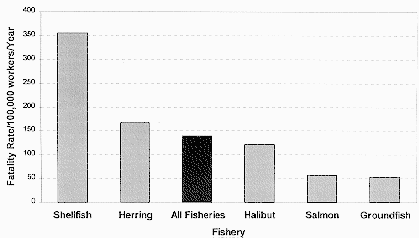
Figure 1. Commercial Fishing Fatality Rates by Fishery–Alaska, 1991-1996.
Source: NIOSH [1997]. [return to text]
Fishing fatalities occur primarily during the months when the greatest number of fishermen are working, particularly in the near-shore fisheries (e.g., salmon, herring and cod) from May-September (68, 47%). However, a peak also occurs in November, January, and February (56, 38%) when the winter crab fisheries are open in the Bering Sea (Figure 2). Almost one-half of all fatalities (70, 48%) occurred in the Bering Sea, Southeast Alaska and the Aleutian/Pribilof area (Figure 3).
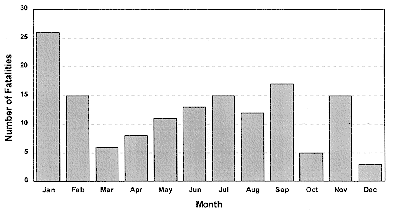
Figure 2. Fishing Fatalities by Month–Alaska, 1991–1996, n=146.
Source: NIOSH [1997]. [return to text]
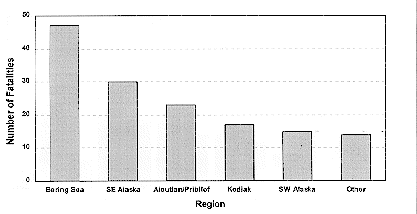
Figure 3. Fishing Fatalities by Location–Alaska, 1991-1996, n=146.
Source: NIOSH [1997] [return to text]
Most (128, 87%) of the deceased fishermen drowned; were presumed drowned; and/or died from hypothermia as a result of either vessel-related events (capsizing or sinking’s) (92, 63%), falling overboard (31, 21%), or diving incidents (5, 3%). Other victims died as a result of deck injuries (e.g., crushed by crab pots, entangled in winches). Of the 92 people who were killed in vessel-related events, most (44, 48%) were participating in the shellfish fishery. Likewise, of those who fell overboard and drowned, the largest fishery-specific number of decedents (13, 42%) were also participating in the shellfish fishery. The falling-overboard fatalities can be divided further into the reasons for the victims being immersed in water: entanglement in a net or line (9, 29%), unobserved fall (victim missing from vessel) (8, 26%), observed fall (8, 26%), or washed into the water (6, 19%) (Figure 4).
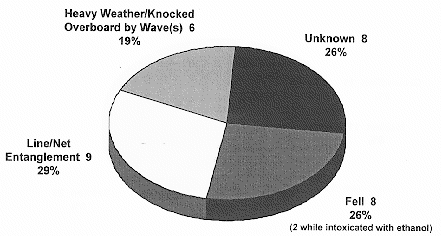
Figure 4. Man Overboard Events by Circumstance–Alaska, 1991-1996, n=31.
Source: NIOSH [1997] [return to text]
Of the 128 fishermen who drowned, almost half of them (60, 47%) were not wearing any type of personal flotation device (PFD) while 12 (9%) were. For 56 (44%) of those who died or are presumed dead, primarily those lost at sea with no body recovered, it is unknown whether they were wearing any type of PFD. Of fishermen involved in a fatal incident in which at least one other fisherman drowned, 55% of the survivors were wearing an immersion suit (a.k.a. survival suit). Of the 31 fishermen who died after falling overboard, none was wearing any type of PFD.
Just over one-half (51%) of the fishermen who died in Alaska from 1991-1996 were not year-round residents of Alaska. Many vessels and crew members come from Washington, Oregon, and California to fish in Alaskan waters.
The number of fatalities varied by fishery (Figure 5). From 1991 to 1996, in the Alaskan crab fisheries, 30 fatal events resulted in 61 (42% of all) fatalities. Forty-three percent (n=13) of these incidents and 72% of the fatalities were vessel-related, and the majority (62%) of the vessels reportedly were operating in heavy weather conditions (defined as winds > 25 knots and/or waves > 15 feet). In the salmon fishery in Alaska, 23 fatal events resulted in 26 fatalities. Eleven of these incidents (14 fatalities) were vessel-related, but most (73%) of the vessels were reportedly sailing in moderately calm waters at the time of the incident. Ten of these 26 salmon fishing-related fatalities occurred after falling overboard, half of them in calm waters. From 1991-1994, 6 fatal events resulted in 11 fatalities in the halibut fishery in Alaska; all of these incidents were vessel-related, and all occurred in heavy seas. No fatalities occurred in the halibut fishery in 1995 or 1996.
Figure 5. Fishing Fatalities by Fishery–Alaska, 1991-1996, n=146.
Source: NIOSH [1997] [return to text]
Diving fatalities are an emerging problem in Alaska’s commercial fishing industry as five divers died while working during the study period. Three of these diving fatalities occurred among inexperienced divers attempting to untangle nets or lines that had snagged on the ocean floor or vessel propellers. The divers themselves became entangled in the nets or the lines and could not surface. Of the three victims, one was a newly certified recreational diver, another was reportedly experienced but not certified as a recreational diver, and the third also had no type of diving certification and very little experience. These divers were all using self-contained underwater breathing apparatus (SCUBA) equipment. The other two diving fatalities involved sea cucumber divers who drowned while diving. Both divers were using surface-supplied-air diving equipment.
Discussion
Our mortality findings reinforce those for the Alaska commercial fishing industry in previous reports of surveillance data, incident investigations, and survey information collected for 1980-1992 by NIOSH [Schnitzer et al. 1993; Schnitzer et al. 1991], USCG [USCG 1992a], NRC [NRC 1991], NTSB [NTSB 1987] and the University of Alaska [Knapp and Ronan 1991]. These data indicate that the workers at greatest risk for fishing-related fatal injuries are those who fish for crab aboard unstable vessels. Our more recent findings (since 1992) show a reduction of fatalities in the vessel-related events involving fisheries other than crab (Figure 6).
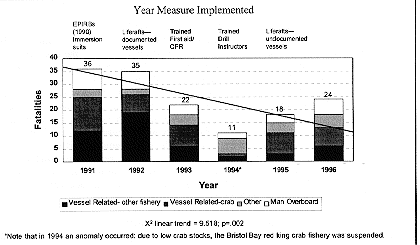
Figure 6. Implementation of the Commercial Fishing Industry Vessel Safety Act of 1988 and Fishing Fatalities by Year–Alaska, 1991-1996, n=146.
Source: NIOSH [1997] [return to text]
Since the implementation of the CFIVSA, requiring survival suits, life rafts, electronic position indicating radio beacons (EPIRBs), and emergency drill training, fewer fishermen have been lost after their vessels either capsized or sank. It should be noted that in 1994 an anomaly occurred due to a reduction of crab stocks and a closure of the largest red king crab fishery (Bristol Bay) in Alaska [Lincoln 1997a]. The processed net weight of crab was down 51% in 1994 from 1992 [ADF&G 1995].
Our analysis of USCG vessel casualty statistics [USCG 1996] from 1991-1996 revealed that over the 6-year period, the number of vessel casualties (vessels lost) has remained relatively constant (mean 34.5, median 37), as has the number of people on board (number at risk) (mean 106.7, median 110). However, the case-fatality rate (number killed/number at risk) associated with these vessel casualties has dropped significantly from 27% in 1991 to 11% in 1996 (Table 1).
Management Regimes
Until recently, the shrinking halibut resource was managed as a “derby style” fishery, with progressively shorter seasons. This often forced participants, in order to fish at all, to fish in unsafe weather conditions, work continuously for long periods without rest, and possibly overload their vessels due to limited openings (usually 24-hour periods on dates established months before, and not changeable in response to weather conditions). In 1995, a new fishery management regime, individual fishing quotas (IFQ), was implemented for the Alaskan halibut and sable fish (black cod) fisheries.
Table 1.
Recent Decrease in the Case Fatality Rate,
Alaska Commercial Fishing Industry, 1991-1996.
| Year | Number of vessels lost* | Number of persons on board* | Number of persons killed* | Case Fatality Rate**,*** |
|---|---|---|---|---|
| 1991 | 39 | 93 | 25 | 27% |
| 1992 | 44 | 113 | 26 | 23% |
| 1993 | 24 | 83 | 14 | 17% |
| 1994 | 36 | 131 | 4 | 3% |
| 1995 | 26 | 106 | 11 | 10% |
| 1996 | 38 | 114 | 13 | 11% |
*Source: U.S. Coast Guard. 17th District. Fishing Vessel Safety Coordinator.
**Case Fatality Rate = (number killed / number at risk) x 100%
***Chi-square for linear trend = 14.287, p<0.00016
[return to text]
An IFQ allocation was based upon the participation and catch records from the previous 5 years. The IFQ program assigned individual catch limits for each vessel. IFQs allow each skipper to consider market conditions, weather, and the vessel’s capacity when planning trips. The absence of any fatal events since the implementation of IFQs in the halibut fishery and the drop in USCG Search and Rescue (SAR) missions for the halibut fishery from 33 in 1994 to 7 in 1996 are very encouraging (Figure 7). However, it is not possible to ascertain if a direct cause-and-effect relationship exists between the implementation of IFQs and the reduction of these events.
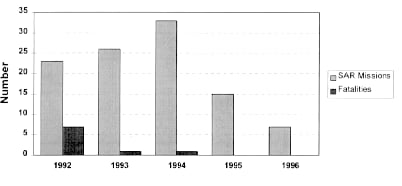
Figure 7. Halibut Fishery-Related Search and Rescue (SAR) Missions and Fatalities by Year–Alaska, 1992-1996.
Source: U.S. Coast Guard, 17th District, Fishing Vessel Safety Coordinator. [return to text]
The Sustainable Fisheries Act (Public Law 104-297 [S. 39]; October 11, 1996, also known as the Magnuson-Stevens Reauthorization Act of 1996) prohibits any fisheries management council from submitting, and the Secretary of Commerce from approving or implementing, any more IFQ programs before October 1, 2000. Also, in submitting and approving any new IFQ programs after that date, the fisheries management councils and the Secretary of Commerce are required to consider a report (from the National Academy of Sciences) studying the IFQ program. Congress is requiring submission of this report by October 1, 1998, and the report must include recommendations to implement a national policy for IFQs.
The report will address, among other things, social and economic issues, and the safety of life and vessels in each fishery. Applying findings of the NAS report to management regimes will be important, since most of the crab, cod, pollock, sea cucumber, and sea urchin fisheries are still managed as non- limited-entry fisheries.
USCG and the CFIVSA
The success of the interventions implemented over the past decade in preventing loss of life in Alaskan fishermen is remarkable. However, the continuing circumstance of 25 to 45 vessels being lost every year and approximately 100 persons requiring rescue annually from cold Alaskan waters places a tremendous economic burden on taxpayers and persistent risk to the rescuers. The average cost of an SAR mission in Alaska is $6800. SAR missions in Alaska average 1100 each year, so the average annual cost is nearly $7.5 million. During the first three quarters of FY 1997, the 17th USCG District has spent over $6.5 million on SAR missions [Jorgenson 1997]. Successful rescue is still dependent on the expertly trained and highly effective men and women of the USCG SAR operations, and are subject to the vagaries of the seas and the weather [Conway and Lincoln 1995]. Furthermore, the young men and women involved in USCG SAR operations themselves experience considerable occupational risks in transit to and during these rescue attempts.
When you call the Coast Guard … you are asking them to risk their lives to save yours. The rescuers neither ask for nor get much in return, and they value their lives as much as we value ours. It is the duty of those who go to sea to avoid getting into situations that require the aid of the rescue services — heed the season, equip your vessel properly, keep a sharp eye for weather changes, shake down a new vessel conscientiously, don’t expect your ship to do something she can’t, pump for your life if you’re sinking, maneuver your vessel if you’re not, think ahead. Anything less and you will be asking more of others than you ask of yourself.”–Peter Spectre [Spectre 1980].
The impressive progress made during the early 1990s in reducing mortality has occurred primarily by keeping fishermen who have evacuated capsized or sinking vessels afloat and warm (using immersion suits and life rafts), and being able to locate them readily via EPIRBs. All of these regulations were required to be implemented between 1990 and 1995 by the CFIVSA. This Act classified all waters in Alaska (including bays, inlets, harbors, and rivers) as “cold” waters (<60°F,<15.6°C), in which hypothermia can lead to death by drowning within minutes of immersion. As a result, immersion suits are required by the CFIVSA to be available for all crew members on board vessels operating in Alaskan waters [46 CFR 28.110]. Immersion suits provide flotation and thermal protection from cold water temperatures and are critical for survival during immersions in cold waters [Steinman 1994]. This intervention has permitted many fishermen to survive much longer in the water while awaiting rescue. Given their bulkiness, it is not practical to wear immersion suits routinely while working on deck (Appendix I ). However, availability of immersion suits combined with training (see Recommendation #5 on page 11) can improve emergency preparedness and response among fishermen, and thereby improve the chances of survival.
The CFIVSA enabled the USCG to set up the Voluntary Dockside Exam Program in 1992. It is a voluntary program in which fishermen permit USCG examiners to board their vessels and review the safety equipment onboard, including EPIRBs, immersion suits, and life rafts, and to discuss the new regulations. The examiners include individuals with a wide marine safety, search and rescue, and law enforcement background. The program has been quite successful as a means to communicate with and educate fishermen. The Dockside Exam Program helps bring vessels into compliance and encourages the crew to seek required training. One drawback of the Voluntary Dockside Exam Program is that it does not address vessel stability, hull integrity, machinery, construction, or fire protection standards [Lincoln 1997b].
Recommendations
The etiologic factors for Alaska commercial fishing deaths are complex (Appendix II, Matrix #1). Gear type, fatigue, and environmental conditions also contribute to the severity of work-related incidents.
The CFIVSA primarily emphasizes the use and availability of safety equipment during and after a disaster at sea (Appendix II, Matrix #2). The findings presented in this report demonstrate considerable reductions in fatalities in some sectors of this industry, while persistent problems remain in other areas. We recommend augmenting this approach to commercial fishing fatalities by preventing these disasters in the first place, as well as continuing to prepare to react to them if they should occur. Additional efforts must be made to reduce the frequency of vessel capsizing and sinkings, particularly during crabbing operations, and to prevent fishermen from falling overboard.
The Alaska Interagency Working Group for the Prevention of Occupational Injuries, established in 1991, provides an opportunity for various Federal, State, and municipal agencies involved in occupational safety and health to meet. In addition to fostering better cooperation between agencies, this group can develop and assist industry in implementation of intervention strategies that will prevent some of the injuries and illnesses that occur in Alaska’s work places. During the March 1997 Working Group meeting, several subcommittees were formed, including a commercial fishing subcommittee, which includes governmental agencies, nonprofit (and nongovernmental) organizations, and industry representatives. The purpose of this new fishing industry-specific working group is to identify the root causes of fishing casualties, to develop countermeasures for each root cause, and to report their findings. The working group will also formulate recommendations to reduce these fatalities and participate in the evaluation of the effectiveness of interventions. The critical etiologic factors the subcommittee has identified that must be addressed for definitive, primary prevention efforts in this industry are vessel stability and hull integrity to keep vessels afloat, licensing and training of operators and crew to ensure a minimum level of competency, management regimes, avoidance of the most harsh sea and weather conditions, falls overboard, and unsafe diving practices (Appendix II, Matrix #3).
Vessel Stability and Hull Integrity
Recommendation #l: A requirement for periodic stability reassessment and vessel inspection of all vessels should be seriously considered, as equipping and retrofitting can substantially affect the stability of vessels.
Recommendation #2: Minimum specifications for watertight components and bulkheads sufficient to keep swamped or capsized vessels afloat should also be developed, implemented and evaluated.
Since vessel-related events continue to claim the most lives, they warrant the greatest attention. It has been shown previously that the presence of crab pots on deck provide the most potentially dangerous safety condition and that older wooden vessels are most commonly involved in capsizing’s [Storch 1974]. While the requirements of the CFIVSA have greatly improved the chances of a successful rescue after a vessel capsizes or sinks, the capsizing events themselves should be generally preventable, as vessel stability is measurable and predictable. By integral design enhancements and subsequent modifications (e.g., retrofitting of sponsons); by careful attention to loading, possibly with additional (empirical) stability tests when loaded; by considering use of collapsible crab pots; and by anticipating and planning for the uses of the vessel and for necessary adaptations to environmental factors, vessels can be made much less susceptible to capsizing/sinking due to sudden changes in weather. In their 1991 report [NRC 1991] the NRC recommended that the USCG establish minimum standards for vessel design and construction or conversion of vessels.
As stated previously, the NTSB conducted a Safety Study of Uninspected Commercial Fishing Vessel Safety in 1987 [NTSB 1987]. It recommended seeking legislative authority to require that stability tests be conducted and that complete stability information be provided to the captains of commercial fishing vessels (NTSB Recommendation M-86-11) [NTSB 1987]. Currently, there are stability requirements for new or altered (after September 15, 1991) vessels greater than or equal to 79 feet in length. While stability requirements for vessels less than 79 feet have been controversial, development of stability criteria for these smaller vessels is imperative, even if it requires an entirely different method and approach than that used for large vessels.
Licensing and Training of Skippers
Recommendation #3: A thorough assessment should be made of current training requirements and efforts, and deficiencies should be immediately corrected.
The NRC recommended that the USCG establish regulations requiring that each person involved in vessel operations acquire skills necessary to their duties through a certification program and licensing requirement [NRC 1991]. NTSB also recommended in its report that the USCG seek legislative authority to require the licensing of captains of commercial fishing vessels, including a requirement that they demonstrate minimum qualifications in vessel safety including rules of the road, vessel stability, firefighting, water tight integrity, and the use of lifesaving equipment (NTSB Recommendation M-85-68) [NTSB 1987].
The USCG has submitted a licensing plan and inspection program to Congress [USCG 1992b]. The licensing plan requires knowledge of stability for the master of a vessel. The persistent contribution of vessel instability to vessel casualties (in the face of no implementation of such a licensing program and to the consequent deaths of fishermen should be addressed.
Human Factors
Recommendation #4: Consideration should be given to establishing adequate watchkeeping and staffing requirements for all vessels.
Minimum watchkeeping and staffing requirements currently exist for uninspected fishing vessels over 200 gross tons. It has been well documented that long hours and fatigue are a major part of fisheries in Alaska [NRC 1991]. The hazards of deep-sea fishing vessels have been summarized previously by asserting that the causes of vessel casualties include negligent navigation and fatigue [Schilling 1971].
Training of Crew
Recommendation #5: Consideration should be given to requiring the successful completion of basic fishing safety training, such as those programs currently offered by the Alaska Marine Safety Education Association (AMSEA), before an Alaskan (state) crew license or a commercial fishing permit is issued.
In addition to the safety gear requirement, the CFIVSA requires assurance from the master of each vessel that safety drills involving the use of safety equipment are conducted at least once a month. The individual conducting the safety drills must be trained in the proper procedures. AMSEA, formed in 1985 to address many of the risks described here, has played a major role in preparing Alaska’s fishermen to meet these needs. AMSEA provides an intensive 18-24 hour course covering emergency preparedness, response, and survival training which includes the use of this survival equipment and instructions for conducting emergency drills on deck. As of the end of 1996, AMSEA had trained 3300 fishermen. A retrospective evaluation of the effectiveness of this training showed that it had a measurable effect in reducing drownings among commercial fishermen [Perkins 1995]. In other studies it has been recommended that improving worker training, using PFDs, maintaining safety equipment, and developing improved clothing and personal flotation devices can save lives [Driscoll et al. 1994].
Management Regimes
Recommendation #6: All current and proposed management regimes should be examined from a safety and health perspective.
The management of fisheries must ensure the preservation of the resource, while optimizing the opportunities for fishermen, and allowing local authorities and fishermen the freedom to exercise judgement about the advisability of fishing in current conditions so as not to exert undue pressure to fish in poor weather.
Harsh Sea and Weather Conditions
Recommendation #7: Weather information should be more closely heeded.
Weather buoy observations are now accessible via the Internet and should be used in conjunction with nomographic estimates for icing hazard, [USCG 1986; Ball 1978], enabling the trained skipper to make an informed decision whether to sail, return to port, or seek a protected anchorage before the worst conditions occur.
Icing of the ship’s superstructure can rapidly compromise the stability of any vessel and predispose it to capsizing. Icing nomograms show the relationship between air temperature, surface wind speed, and water temperature to the rate of ice accumulation, and can be used to predict icing hazard [Ball 1978]. The National Weather Service includes vessel icing forecasts with their regular weather broadcasts as a service to fishermen. The forecasts are given in four categories: light, moderate, heavy, or very heavy freezing spray [Ball 1978] (Appendix III ).
Falls Overboard
Recommendation #8: All fishermen should wear PFDs when on the deck of any vessel [NIOSH 1994b].
In overboard events where the victim is entangled in the gear, or is not observed falling overboard, a PFD might not result in a successful rescue. However, in 45% of the fatal man-overboard (MOB) cases from 1991 to 1996, the victim was not tangled in gear and was observed falling overboard, and should have been floatable and recoverable if the vessel had been adequately prepared for an emergency. Also, anecdotal concerns by fishermen about entanglement in lines by many PFD’s are not supported by the events. All entanglements resulting in a fatal MOB event involved the entanglement of an extremity (arm or foot) rather than clothing covering the torso. An expanding number of compact PFD options unlikely to interfere with deck operations (self-inflating vests, pile-lined jackets, and suspenders), have become commercially available during the past decade.
Recommendation #9: MOB alarms should be thoroughly evaluated and widely deployed if such evaluations demonstrate that the devices are effective.
Man overboard alarms are worn by fishermen to alert others that they have fallen overboard. The devices operate by automatically setting off an alarm when the fishermen fall into the water. These devices, which can be linked to personal EPIRBs and vessel automated cutoff (“deadman”) switches, have recently become commercially available. They show promising results in efficacy studies, although their effectiveness in saving someone from drowning remains unevaluated.
Recommendation #10: Thorough study of the handling of lines, especially during deployment of crab pots, should be conducted to reduce worker exposure to this hazard.
The frequency of line entanglement resulting in man-overboard events is high. As indicated elsewhere in this bulletin, many of these events are not likely to be mitigated by PFD usage.
Diving Events
Recommendation #11: A training curriculum should be developed, implemented, and evaluated for fishermen who are harvesting seafood or clearing lines or nets by diving.
Dive-related fatalities have emerged as a new problem in Alaska. Recently a new dive fishery for sea cucumbers has emerged in Southeast Alaska and Kodiak, and some fishermen for other species have encountered trouble when they dive to check their vessels or to clear nets or lines.
During 1992-1993, six persons died while diving for sea urchins off the coast of Maine. Authorities identified inexperienced divers and persons unfamiliar with operating vessels in adverse sea and weather conditions as the groups at greatest risk [CDC 1994]. As a result, Maine passed emergency regulations to require (1) persons to be a resident of Maine to participate in the fishery, (2) divers must show proof that they are certified in basic open water diving from any recognized national association, (3) both divers and tenders must attend a competency class, and (4) tenders must be licenced by attending a competency class. Since the implementation of this program in 1994, only one diver has been killed [Fetterman 1997].
Current Efforts and Future Directions
Effective surveillance and interventions for commercial fishing-related injury mortality in Alaska, historically the worst-case setting in the U.S., should provide a useful paradigm and productive venue for prevention of similar deaths elsewhere in the U.S. The substantial progress made to date in Alaska’s most hazardous industry through the thoughtful application of the public health model and incorporation of new technologies and comprehensive training should encourage others to try similar approaches elsewhere and for other problems. Building further on the progress already made in preventing deaths in this historically dangerous occupation could lead to a much safer working life for commercial fishermen plying their trade in Alaskan waters.
References
ADF&G [1995]. Alaska Department of Fish and Game. Alaska commercial fisheries ex vessel and wholesale values by major fishery. Juneau, AK.
AMSEA [1992]. Marine Safety Instructor Training Manual. Sitka, AK: Alaska Marine Safety Education Association, p. E-30.
Ball, J [1978]. Vessel icing forecasts, part of winter fishing safety. Alaska Seas and Coasts, University of Alaska Publication of the Alaska Sea Grant Program, Vol. 6, No. 5, December 1978 – January 1979 (reprint from Alaska Seas & Coasts, Vol. 4, No. 5, December 1976).
Bell CA, Stout NA, Bender TR, Conroy CS, Crouse WE, Myers JR [1990]. Fatal occupational injuries in the United States, 1980 through 1985. JAMA 236:3047-3050.
CDC (Centers for Disease Control and Prevenion) [1993]. Commercial fishing fatalities–Alaska, 1991-1992. MMWR 42(18):350-9.
CDC (Centers for Disease Control and Prevention) [1994]. Fatalities associated with harvesting of sea urchins–Maine, 1993. MMWR 43(12): 240-242.
CFR. Code of Federal Regulations. Washington DC: U.S. Government Printing Office, Office of the Federal Register.
Conway GA, Lincoln JM [1995]. Preventing deaths in Alaska’s fishing industry. Public Health Reports 110:700.
Driscoll TR, Ansari G, Harrison JE, Frommer MS, Ruck EA [1994]. Traumatic work-related fatalities in commercial fishermen in Australia, Occup Environ Med 51:612-616.
Fetterman J [1997]. Dive harvest safety in Maine: education that works. Sitka, AK: Alaska Diving Safety Workshop, July 25, 1997.
Focht R [1986]. Employment and gross earnings in Alaska’s commercial fisheries: estimates for all participants and residents of Alaska, Washington, Oregon, and California, 1983-84. Report No. 86-8. Juneau, Alaska: Commercial Fisheries Entry Commission.
Jorgenson S [1997]. U.S. Coast Guard, Search and Rescue Cost Report. Fishing Vessel Safety Office, Juneau, AK.
Kennedy R, Veazie M, Conway G, Amandus H [1994]. Fishing deaths in Alaska vary by fishery. AmJ Public Health 84:496.
Knapp G, Ronan N [1991]. Fatality rates in the Alaska commercial fishing industry. Alaska Sea Grant College Program, Pub. No. AK-SG-90-03. Anchorage, AK: University of Alaska, Institute of Social and Economic Research.
Lincoln, J [1997a]. Telephone conversation on July 30, 1997, between J. Lincoln, Alaska field station, Division of Safety Research, National Institute for Occupational Safety and Health, Centers for Disease Control and Prevention, Public Health Service, U.S. Department of Health and Human Services, and H. Savikko, Fisheries Information Officer, Division of Commercial Fisheries, Alaska Department of Fish and Game, Juneau, AK.
Lincoln, J [1997b]. Telephone conversation on May 20, 1997, between J. Lincoln, Alaska field station, Division of Safety Research, National Institute for Occupational Safety and Health, Centers for Disease Control and Prevention, Public Health Service, U.S. Department of Health and Human Services, and C. Medlicott, Commercial Fishing Vessel Safety Program Coordinator, Marine Safety Office Anchorage, U.S. Coast Guard, U.S. Department of Transportation, Anchorage, AK.
NRC [1991]. Fishing vessel safety: blueprint for a national program. National Research Council (U.S.), Marine Board, Committee on Fishing Vessel Safety. Washington, DC: National Academy Press.
NIOSH [1993]. Fatal Injuries to Workers in the United States, 1980-1989: A Decade of Surveillance. Cincinnati, OH: U.S. Department of Health and Human Services, Public Health Service, Centers for Disease Control and Prevention, National Institute for Occupational Safety and Health. DHHS (NIOSH) Publication No. 93-108.
NIOSH [1994a]. Occupational injury rates in the Alaska commercial fishing industry: final report March 7, 1994. Anchorage, AK: U.S. Department of Health and Human Services, Public Health Service, Centers for Disease Control and Prevention, National Institute for Occupational Safety and Health.
NIOSH [1994b]. NIOSH Alert: request for assistance in preventing drownings of commercial fishermen. Cincinnati, OH: U.S. Department of Health and Human Services, Public Health Service, Centers for Disease Control and Prevention, National Institute for Occupational Safety and Health. DHHS (NIOSH) Publication No. 94-107.
NIOSH [1997]. Alaska Occupational Injury Surveillance System. Anchorage, AK: U.S. Department of Health and Human Services, Public Health Service, Centers for Disease Control and Prevention, National Institute for Occupational Safety and Health. Unpublished database.
NTSB [1987]. Safety study, uninspected commercial fishing vessel safety. National Transportation Safety Board, Washington, DC 20594, P1387-917003.
Perkins R [1995]. Evaluation of an Alaskan marine safety training program. Public Health Reports 110:701-2.
Rodgers GW, Listowski RF, Mayer D [1980]. Measuring the socioeconomic impacts of Alaska’s fisheries. Anchorage, AK: University of Alaska, Institute of Social and Economic Research.
Schilling SF [1971]. Hazards of deep sea fishing. Br J Ind Med 28:27-35.
Schnitzer PG, Landen D, Russell J [1991]. Estimating deaths from work-related injuries in Alaska’s fishing industry, 1980-1988 [Abstract]. In: Program and abstracts of the Epidemic
Intelligence Service 40th Annual Conference: 28-9. Atlanta: U.S. Department of Health and Human Services, Public Health Service, Centers for Disease Control and Prevention.
Schnitzer PG, Landen DD, Russell JC [1993]. Occupational injury deaths in Alaska’s fishing industry, 1980 through 1988. AmJ Public Health 83: 685-688.
Spectre P [1980]. North Atlantic shakedown: the abandonment of the John F Leavitt. Wooden Boat Magazine 33:20-29.
Steinman AM [1994]. Protective clothing in cold water survival. In: Myers ML, Klatt ML eds. Proceedings of the National Fishing Industry Safety and Health Workshop. Anchorage, AK: U.S. Department of Health and Human Services, Public Health Service, Centers for Disease Control and Prevention, National Institute for Occupational Safety and Health. DHHS (NIOSH) Publication No. 94-109.
Storch, RL [1978]. Alaskan king crab boat casualties, Marine Technology 15:75-83.
USCG [1986]. USCG Navigation and Vessel Inspection Circular No. 5-86, August 18, 1986.
USCG [1992a]. United States Coast Guard Main Casualty (CASMAIN) database, 1982-89. Washington, DC: U.S. Department of Transportation, United States Coast Guard, Marine Investigations Division.
USCG [1992b]. A plan for licensing operators of uninspected federally documented commercial fishing industry vessels. U.S. Coast Guard, Washington D.C.
USCG [1996]. District Fishing Vessel Safety Office Casualty Database 1991-1996. Juneau, AK: U.S. Coast Guard, Department of Transportation.
Voelker RP, Schulze RH, Wohl GM [1983] Alaska Marine Ice Atlas. Arctic Environmental Information and Data Center. University of Alaska. p. 267.
Appendix I
Immersion Suit “Survival Suit”
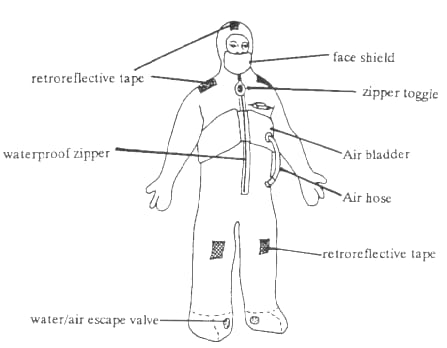
- Buoyancy Provided by closed cell foam neoprene.
- Designed to be worn when abandoning ship.
- The suit and its inflatable bladder provide excellent buoyancy.
- Offers the best hypothermia protection of any PFD.
Source: AMSEA [1992]. Reprinted with permission. Drawing by J. Schmitts. [return to text]
Appendix II
Characteristics of, and Countermeasures for, Alaska Commercial Fishing Injury Events (Analyses Using Haddon’s Matrix)
Matrix 1. Features of Commercial Fishing Injury Events–Alaska
| Phase | Host/Human | Agent/Vehicle | Environment |
|---|---|---|---|
| Pre-event | Captain & Crew fatigue, stress, prescription or illegal drugs/alcohol, inadequate training/exposure | Unstable vessel Unstable work platform Complex machinery and operations |
High winds Large waves Icing Short daylight Limited fishing seasons Vessels far apart |
| Event | Captain &Crew reaction to emergency PFD not available/not working |
Listing or capsized vessel Delayed abandonment Emergency circumstance not understood Man overboard |
High winds Large waves Darkness Poor radio communications Cold water |
| Post-event | Poor use ofavailable emergency equipment Hypothermia Drowning Lost at sea |
Vessel sinking Poor crew response toMOB |
High winds Large waves Cold water |
Matrix 2. Alaska commercial Fishing Injury Countermeasures
Commercial Fishing Vessel Safety Act of 1988
(Implemented 1990-1995)
| Phase | Host/Human | Agent/Vehicle | Environment |
|---|---|---|---|
| Pre-event | Drills | Navigation publications Compasses Anchors |
|
| Event | Immersion suits PFDs |
Fire extinguishers/systems Fireman’s outfits/SCBAs High water alarms |
|
| Post-event | Immersion suits PFDs |
Distress signals Life rafts EPIRBs |
First aid kits CPR & first aid |
Matrix 3. Alaska Commercial Fishing Injury Countermeasures
| Phase | Host/Human | Agent/Vehicle | Environment |
|---|---|---|---|
| Pre-event | Licensing of skipper Increased training on vessel stability Increased drills |
Reassessment ofstability after refitting Retrofitting of sponsons Separating lines from workers |
Evaluate impact ofmanagement regimes for fisheries No-sail guidelines due to weather Development/refinement oficing nomograms |
| Event | Wearing personal flotation devices (PFDs) Man overboard (MOB) alarms Personal emergency | ||
| Post-event |
Appendix III
Icing Nomograms
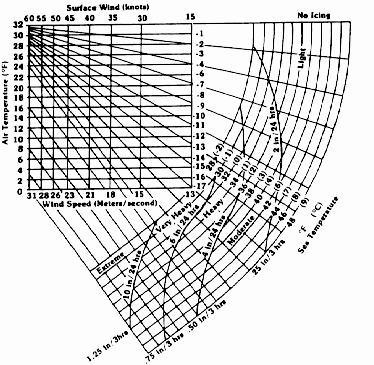
Recommended for use in the Gulf of Alaska and Eastern Bering Sea.
Source: From Arctic Environmental Information and Data Center. Alaska Marine Ice Atlas. 1983.
Categories
| Name | Rate Per 3 Hours |
|---|---|
| Light | .01″ to .25″ |
| Moderate | .25″ to .50″ |
| Heavy | .50″ to .75″ |
| Very Heavy | .75″ to 1.25″ |
| Extreme | 1.25″ or more |
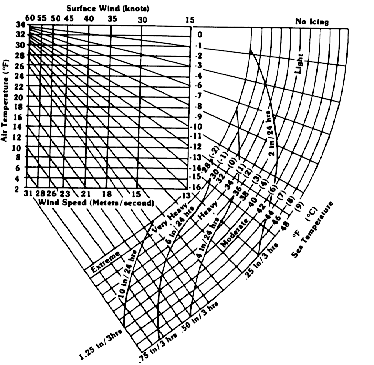
The temperature scale has been relabeled to provide for unusually low humidity (20-50%) conditions. Recommended for use in the Gulf of Alaska and by forecasters only.
Source:  From Arctic Environmental Information and Data Center. Alaska Marine Ice Atlas. 1983. [return to text]

